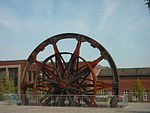Museum Zinkhütter Hof
The museum for industrial, economic and social history for the Aachen area in Stolberg, Zinkhütter Hof eV is a museum for industrial, economic and social history of the Aachen area in Stolberg (Rhld.) In the Aachen city region . It was inaugurated on September 20, 1996 in a former glassworks from the first half of the 19th century in the Münsterbusch district of Stolberg .
History of the building
The facility, originally built by the Société de Charleroy as a glassworks in the 1830s and operated until the 1850s, is a well-preserved ensemble of production hall, workers' apartments and administrative villa from the early phase of German industrialization. The larger and more modern Münsterbusch glassworks was built in the immediate vicinity . In 1904 the later Stolberger Zink bought the complex and put it to various uses. In 1991 the city of Stolberg acquired the Zinkhütter Hof. The conversion to a museum was financed with funds from the state of North Rhine-Westphalia .
exhibition
The permanent exhibition comprises three parts: In addition to needle production in Aachen , the history of the Stolberg materials brass and zinc from Roman times ( Hemmoorer buckets ) to the copper masters to the structural change to zinc smelting in the Eschweiler-Stolberg area in the 19th century is documented. The physical basics of the two elements and the development of the production processes as well as their products and production locations including the history of the companies are presented. The permanent exhibition "Turbo Traffic Transport" presents aspects from the history of regional mobility. In addition to the permanent exhibitions, there are changing special exhibitions of the fine arts or on various topics related to the further history of technology. In the building there is also a large meeting room with around two hundred seats.
The museum has its own educational program for children in which historical technology is explored in a 'criminalist' manner. In addition, guided tours for school classes and the organization of children's birthdays are offered. An appointment for a needle manufacture for the children can be booked together with a guided tour of the museum. The museum gnome Galminus aims to bring the children closer to the most important raw material in zinc and brass production.
Outdoor area
A memorial on the site, which is designed after a swastika formed from barbed wire , commemorates the victims of National Socialism in Stolberg. This location was chosen because a Stolberger Zink forced labor camp with 106 men was in the immediate vicinity on the premises of the Zinkhütte Münsterbusch in Cockerillstrasse during the Second World War .
In the outdoor area, other exhibits from economic history can be viewed, such as a large flywheel and a VEGLA factory train with a Deutz 46385/1947 as a locomotive.
The museum management is housed in the former administration villa.
- Outdoor exhibits and administration
literature
- Michael Käding: Balance sheet and possibilities of documenting the industrial heritage of the region: Archive and Documentation Center Museum Zinkhütter Hof , in: Made in Aachen. Contributions to regional technology, economic and social history, ed. Association for regional technology, economic and social history, HisTech, Aachen 2000, pp. 60–69
- Sebastian Wenzler: The Museum Zinkhütter Hof in Stolberg, in industrial culture and technology history in North Rhine-Westphalia. Initiatives and associations. Edited by the German Society for Industrial Culture. Klartext, Essen 2001, pp. 93–96
Web links
Individual evidence
- ↑ Norbert Nussbaum, Ulrich Stevens (Red.): The early history of the Zinkhütter Hof in Stolberg. In: Monument culture in the Rhineland: Festschrift for Udo Mainzer on his 65th birthday . Werner, Worms 2010, ISBN 978-3-88462-300-8 , pp. 231 f .
Coordinates: 50 ° 46 ′ 30.1 ″ N , 6 ° 13 ′ 1.3 ″ E






